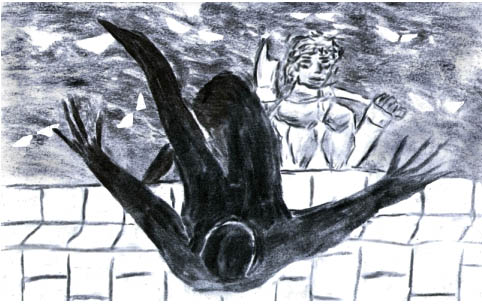 The balance of power only changed in the 13th Century, when a huge influx of catholic monks came to London, among them, the Dominicans and Franciscans, or Black and Greyfriars. The Shadowlands suffered from a similar influx of hundreds of Heretics, carrying their religion on to the other side of the Shroud. The Black and Greyfriars became a regular sight in the London Deadlands led by Blackfriar Brother Dominic, and Greyfriar Brother Francis. In the early 14th Century, an attempt was made by the two orders of friars to wrest control of the city from the hands of those acting on behalf of the Hierarchy. The Legions of Stygia were ill-staffed and unprepared for the attack, and for the fervour with which the Heretics fought. For several years, the battle was fought both on the open streets, and over the roofs of the city. Until the middle of the 14th Century, it seemed as if the Heretics had the upper hand, and they may even quell the Hierarchy and gain control of London. However, fortunately for the Hierarchy (a coincidence those in-the-know are more than aware of), in 1348-1349 the Black Death killed a third of the population of the city, bolstering the ranks of the Skeletal Legion by nearly 500%. A high-ranking Skeletal Legionnaire by the name of Matthew Thatcher, was quick to send the newly dead onto the front-line, and within a decade, the Heretic threat was greatly reduced, although it did not entirely disappear until 1531 when Henry VIII broke with the Catholic church and disbanded the monasteries, cutting the Heretics off from a supply of new recruits. It was only then that the two leaders of the Heretic alliance were supposedly hunted down and killed. The disbanding on the monasteries in the Skinlands
caused massive amounts of land previously owned by the church
to open up for habitation, and soon, the population of London
was rising rapidly. Over the next few hundred years, towns such
as Southwark and Whitechapel (1500's), Bethnal Green and Spitalfields
(1700's), Deptford and Shepherds Bush (1800's), and Wimbledon
and Surbiton (1900's) were all swallowed up by the growth of
the city, leading to an even greater degree of cultural diversity
and patchwork community. London is not one city, but many. About the same time, towards the end of the 16th Century, the Guilds were cast out of London, and the first Necropolis was founded there. Trade suffered badly for quite some time with the loss of the Guilds, but the Hierarchs finding themselves in control of this new and dangerous project were quick to seize control of the situation, putting their own Restless talented in Inhabit, Argos and Moliate in where the Guilds had been cast out. That many of the same faces remained on the dockside, manning the traderoutes and beginning to found the forges and expand the Haunt over the Thames, was a fact that most in power chose to ignore, and most at ground-level chose not to mention. Soon, the area around the London Bridge Haunt was thriving to new-found heights. When the Hierarchy took over control of the city and began to establish their Necropolis, the population of the city skyrocketed. Rooftop markets and walkways were scattered everywhere, and hoards of relic vessels drew up and down the river each day. To begin with, the Anacreons of the Hierarchy enjoyed an almost equal split of power, and the varying cultures and races were all governed with a surprisingly loose hand. The Guilds were also allowed to maintain a stronger presence than in the other fledgling Necropoli, and possessed power almost equal to that of the Hierarchy, although always behind closed doors. By far the largest Guilds in London at this time were the Artificers and the Harbingers, who, together, worked to exploit the fruitful trade routes the city had to offer, although the Spooks were approaching them in power. Further outbreaks of Plague were commonplace, occurring throughout the 15 and 1600's, and feeding the Skeletal Legion with countless recruits. Soon, Matthew Thatcher, the now Skeletal Anacreon, was as good as the Head of State for the city, and all the other Anacreons were nothing but window-dressing. Still, they met behind his back, and planned a resurgence. Even in the halcyon days of the city, unrest was swelling behind closed doors. Civil War in the 1650's brought many more across the Shroud, this time boosting the Grim Legion, and in 1666, the Great Fire of London not only added to the numbers of the Emerald Legion, but also put an end to the Black Death. The balance of power looked as if it may shift away from the Skeletal Legion, and for a while, politics within the city became more heated as each Legion worked hard manipulating the lands of the living and the dead for their own personal gain in this, the oldest and most prestigious of Necropoli. The decree from reinstated monarch Charles II stated that buildings should be made of stone in the future, to prevent the spread of further fires. The building and rebuilding that followed fed the Shadowlands with massive amount of relic material from which to build the rooftop walkways, and reinforce the massive Haunt on London Bridge, whose pale towers were spiraling into the London sky. |